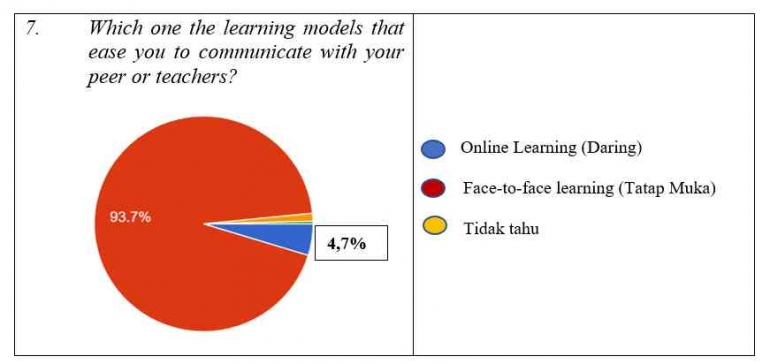Based on the research result, students of SMAN 52 North Jakarta preferred to apply face-to face learning while online learning during COVID-19 pandemic because it is easier to achieve the learning goals, it described a real school environment, easy to build communication with their friend if they attend to school, and it is more flexible learning models; because the students could freely and directly ask the teacher regarding the difficult materials and no delay connection while they are studying. In addition, SMAN 52 North Jakarta is still subjected to the health protocol by the Government during the learning process at school because the students are more motivated to hold face-to-face learning rather than online learning, so that the school organizer creates the health environment during the learning process is being held.
Suggestion
As far as the writer's concerned, online learning is still possible to be applied as new model of learning process due to the technology advances and it can be more efficient for students or the teacher because they only remote and access from a distance. However, the teachers and the students should be ready for the preparation of online learning from the materials, gadgets or devices support, and internet connection, in addition the application for online learning. If the teachers and the students are not ready for online learning, the learning goals and learning process will be failed and it is very dangerous issues for the educational sectors.
REFERENCES:
Ameliana, I. (2017). "Teacher-centered or Student-centered learning approach to promote learning?" Jurnal Sosial Humaniora, 10(2), 59-61. doi:10.12962/j24433527.v10i2.2161.
Britt, R. (2006), "Online education: a survey of faculty and students", Radiologic Technology, Vol. 77 No. 3, pp. 183-190.
Cahyati, N., & Kusumah, R. (2020). "Peran Orang Tua Dalam Menerapkan Pembelajaran Di Rumah Saat Pandemi Covid 19". Jurnal Golden Age, 4(01), 4--6. https://doi.org/10.29408/jga.v4i01.2203.
Chaney E. G. (2001). "Web-based instruction in a Rural High School: A Collaborative Inquiry into Its Effectiveness and Desirability. NASSP Bulletin", 85(628), 20-35.

















